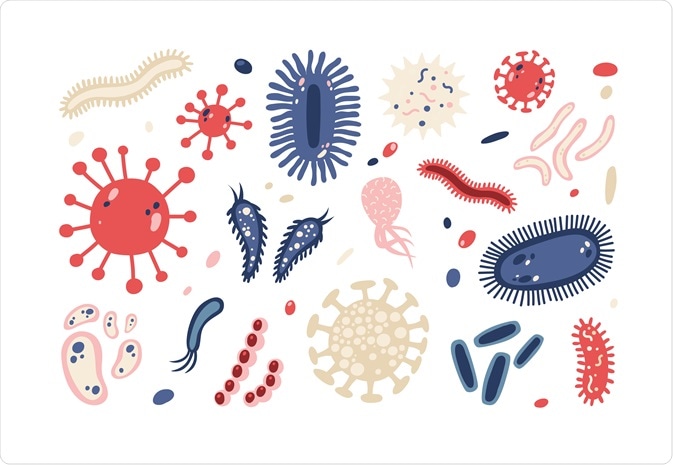Home » Health News »
The Search for Extra-terrestrial Microbes
Studies into astrobiology in conjunction with continuous efforts dedicated to planetary exploration have led to a significant interest in searching for extraterrestrial microbes.
Scientists have developed convincing reasons that support the possibility of extraterrestrial microbes, including the theory of evolution, the presence of extremophiles on Earth, and the rapidly increasing number of Earth-like planets discovered in the last decade.
Due to these reasons, Astrobiologists suggest that life elsewhere in the solar system is most likely to be in the form of microbes and that any other complex extraterrestrial species were likely to have arisen from microbes. Over the years methods including identifying biosignature gases, TCD spectroscopy, microscopy techniques, and thermodynamic approaches have been developed to help with the search for extraterrestrial microbes. Recently, the search has expanded to extraterrestrial locations with harsher environmental conditions.

Image Credit: GoodStudio/Shutterstock.com
Identifying biosignature gases
One method extensively researched to identify extraterrestrial microbes on habitable planets is through biosignature gases. These are gases that are produced by life and accumulate in the atmosphere, and therefore can be used to detect life on various planets through space telescopes.
Recently, an exhaustive list of biosignature gases, totaling approximately 14,000 molecules, has been devised through a combinatorial approach and an intense database and literature search. With this knowledge, the atmosphere of planets and their moons can be analyzed to search for extraterrestrial microbes. However future work is still required to identify biosignature gases composed of larger molecules to extend the list further.
Terahertz circular dichroism (TCD) spectroscopy
Terahertz Circular Dichroism (TCD) spectroscopy is another potential approach recently developed to help discover extraterrestrial microbes and other forms of life in space. This method is based on the understanding that all life forms contain well-structured, chiral, stereochemically pure macromolecules that act as machinery to perform both replicative and metabolic functions. These macromolecules absorb strongly at terahertz frequencies of the spectrum and exhibit circular dichroism.
Such unique properties can allow scientists to distinguish these biological macromolecules from abiological materials through spectroscopy-based methods, and therefore functions as a life-detection technique. TCD spectrometers are currently being designed and built to help with the search for extraterrestrial microbes.
Microscopy techniques
High-resolution scanning and transmission electron microscopy techniques have also been used to identify highly organized and specifically shaped structures representing microbes.
For instance, analysis of a fragment of the Martian meteorite ALH84001 confirmed the presence of polycyclic aromatic hydrocarbons and carbonate globules. These structures provided insights into the possibility of extraterrestrial biota, thus highlighting the importance of using microscopic observations to continue the search for microbes in extraterrestrial environments.
Thermodynamic approaches
A complex thermodynamic approach to detecting extraterrestrial microbes has also been developed. This technique is based on the understanding that living entities require a continual source of usable energy accessed through an electron transport chain.
As a result, extraterrestrial microbes can be found in soils through the extraction and detection of electron transport chain components such as porphyrins, quinones, and flavins. The instrument developed extracts these components from the soil through supercritical carbon dioxide, separates these components by chromatography, and finally detects the components through voltammetry and tandem mass spectrometry.
Another related but simpler thermodynamic approach that could detect extraterrestrial microbes involves measuring the actual existence of a functional and active electron transport chain rather than just its components. This method is based on the use of artificial electron acceptors such as DCIP and respiratory dyes such as XXT that can measure the activity of an electron transport chain. This technique has been used commercially for several years to both identify microbes and characterize their oxidation capabilities.
New studies suggest that the application of this method could be expanded to help search for extraterrestrial microbes in the soils of other planets or their moons.
How the search for extraterrestrial microbes has expanded
To approach the search for extraterrestrial microbes, scientists initially decided to identify bodies of the solar system that had suitable environments habitable for extraterrestrial life. Although this was a reasonable approach, the matter was further complicated as knowledge of extremophiles on Earth increased over the years. Extremophiles are microorganisms that survive and thrive under harsh conditions.
Increasing knowledge of these extremophiles and the conditions in which they can survive has led to an expansion in the number of extraterrestrial locations targeted for the exploration of microbes. Due to this evidence, Scientists are now considering locations with much harsher conditions to search for extraterrestrial microbes.
For instance, it has now been speculated that extraterrestrial microbes may exist on Jupiter’s Moon known as Europa. This is supported by studies of approximately 70 lakes located in Antarctica. These lakes have temperatures ranging from 20 °C to –10 °C and oxygen availability ranging from aerobic to strictly anaerobic. Despite the harsh conditions, microbial life can proliferate in this ecosystem such as cold-adapted Archaea known as Methanococcoides burtoni.
Furthermore, studies of ice cores drilled from the Antarctic surface have revealed an array of microbes including 3000-year-old viable yeasts and 200,000-year-old spore-forming bacteria. This demonstrated the ability of microbes to survive and recover after significant periods in ice. This evidence led to high levels of consideration of extraterrestrial microbes present on Europa, which is thought to have sub-surface lakes and an ice surface similar to Antarctica.
Moreover, other extremophiles have been identified that survive in extremely low concentrations of effective water molecules, also known as low water activity. For example, both culture-based and culture-independent studies confirm that cell division and metabolic activity of halophilic archaea and bacteria can occur in water activities as low as 0.611 aw.
Prior to this discovery, searches for extraterrestrial microbes targeted environments known to contain significant amounts of water as it is one of the principal ingredients of cellular life. However, this new evidence has expanded the search for microbes in extraterrestrial locations with low water activity such as Jupiter.
As more extremophiles and the conditions in which they thrive are discovered, a greater number of extraterrestrial environments will be considered to search for microbes.
References:
- Cavicchioli, R. (2002). Extremophiles and the Search for Extraterrestrial Life. Astrobiology. 2(3): 281-292.
- Crawford, R., Paszczynski, A., Lang, Q., Erwin, D., Allenbach, L., Corti, G., Anderson, T., Cheng, F., Wai, C., Barnes, B., Wells, R., Assefi, T., Mojarradi, M. (2002). Measurement of microbial activity in soil by colorimetric observation of in situ dye reduction: an approach to detection of extraterrestrial life. BMC Microbiology. 2: 1-8.
- Seager, S., Bains, W., Petowski, J. (2016). Toward a List of Molecules as Potential Biosignature Gases for the Search for Life on Exoplanets and Applications to Terrestrial Biochemistry. Astrobiology. 16(6): 465-485.
- Stevenson, A., Burkhardt, J., Cockell, C., Cray, J., Dijksterhuis, J., Fox-Powell, M., Kee, T., Kminek, G., McGenity, T., Timmis, K., Timson, D., Voytek, M., Westall, F., Yakimov, M., Hallsworth, J. (2015). Multiplication of microbes below 0.690 water activity: implications for terrestrial and extraterrestrial life. Environmental Microbiology. 17(2): 257-277.
- Xu, J., Ramian, G., Galan, J., Savvidis, P., Micheal, A., Birge, R., Allen, J., Plaxco, K. (2003). Terahertz Circular Dichroism Spectroscopy: A Potential Approach to the in situ Detection of Life’s Metabolic and Genetic Machinery. Astrobiology. 3(3): 489-504.
Further Reading
- All Microbiology Content
- Microbiology and Food Security
- How Intelligent are Microbes?
- Microbiology and Water Security
- Microbes and Biotechnology
Last Updated: Nov 12, 2021

Written by
Naveen Dha
Naveen graduated from King’s College London where she attained a Bachelor of Science in Biochemistry. Within this course, she chose to study topics pertaining to the biology of cancer, molecular immunology, molecular biology, and protein structure. Throughout her degree, she partook in writing various practical proposals, reports, and literature reviews whilst also gaining multifaceted laboratory and research experience. It was through these projects that Naveen discovered her interest for scientific writing as it allowed her to remain intellectually curious, creative, and detail-orientated.
Source: Read Full Article



